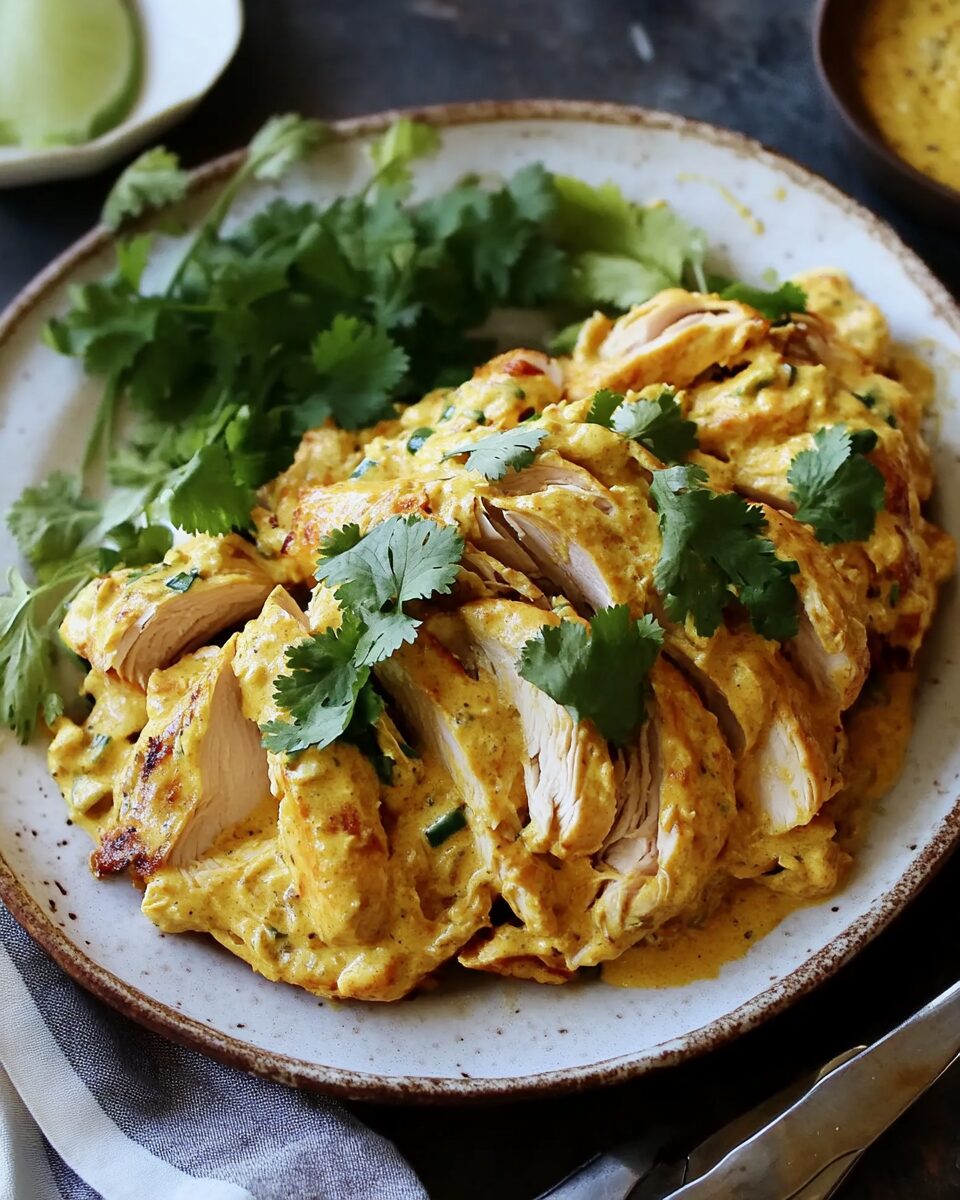The Coronation Chicken is more than just a dish—it’s a flavorful tribute to British culinary heritage. Originally crafted for Queen Elizabeth II’s coronation luncheon in 1953, this salad is a marriage of savory poached chicken, sweet apricots, crunchy almonds, and a creamy, curry-infused dressing that’s utterly divine.
It’s a dish that strikes the perfect balance between comfort and sophistication. Whether served in a sandwich, over crisp greens, or scooped into lettuce cups, Coronation Chicken delivers flavor, texture, and a touch of history in every bite. Ideal for picnics, meal prep, or your next garden party—it’s a royal favorite for a reason!
Full Recipe:
-
3 boneless, skinless chicken breasts (1.5 to 1.75 pounds)
-
Kosher salt
-
1 tablespoon black peppercorns
-
2 bay leaves
-
1 tablespoon extra-virgin olive oil
-
1/2 medium white onion, diced
-
1 tablespoon tomato paste
-
1 tablespoon curry powder
-
1/4 cup red wine
-
2 tablespoons mango chutney
-
Juice of 1/2 lemon (about 1 tablespoon)
-
1/2 cup mayonnaise
-
1/4 cup sour cream
-
1/4 cup chopped dried apricots
-
1/4 cup toasted sliced almonds
-
1/4 cup fresh cilantro leaves, chopped
Directions:
-
Season chicken breasts with kosher salt and place in a large pot with peppercorns and one bay leaf.
-
Cover with water (about 1 inch above the chicken). Bring to a boil, then reduce to simmer. Cover and cook 8–10 minutes or until chicken reaches 165°F.
-
Remove chicken, allow to cool, then shred into large pieces.
-
In a saucepan, heat olive oil over medium heat. Add diced onion and sauté 5 minutes until soft.
-
Stir in tomato paste and cook for 1 minute. Add curry powder and stir for 30 seconds until fragrant.
-
Add red wine, 1/4 cup water, mango chutney, lemon juice, and remaining bay leaf. Simmer and reduce for about 5 minutes. Cool and discard bay leaf.
-
In a bowl, combine mayonnaise and sour cream. Stir in the cooled curry mixture and 1/2 teaspoon salt.
-
Mix shredded chicken with apricots and almonds. Add curry sauce and mix until coated. Gently stir in chopped cilantro.
Prep Time: 25 minutes | Cooking Time: 10 minutes | Total Time: 55 minutes (including cooling)
Kcal: ~320 kcal per cup | Servings: 8 cups
The History of Coronation Chicken
Coronation Chicken is more than just a dish; it is a historical icon. Created for a royal occasion, this dish has evolved over the years and is now a staple in British cuisine. It was first served at the coronation of Queen Elizabeth II in 1953. The dish was initially created by Le Cordon Bleu-trained chef Rosemary Hume, who was tasked with preparing a meal that would reflect the grandeur of the event while being practical for a large group of people. The dish was designed to be served cold, making it suitable for a buffet-style luncheon to celebrate the Queen’s ascension to the throne.
The original version of Coronation Chicken was quite different from what is commonly made today. It combined cold poached chicken with a curried mayonnaise sauce, flavored with ingredients such as curry powder, apricot, and almonds. This unique fusion of British and Indian flavors marked the growing influence of curry in the UK, which was introduced during the British colonization of India. The dish became an instant success and has remained popular ever since.
Cultural Significance of Coronation Chicken
As a dish created specifically for a royal occasion, Coronation Chicken has become a symbol of British cuisine. Its popularity rose during the mid-20th century, especially after Queen Elizabeth II’s coronation. It became associated with a sense of national pride and celebration. Over time, it was served at various events, from street parties to formal gatherings, cementing its place in British culinary tradition.
The dish is also a reflection of the changing landscape of post-war Britain. After World War II, there was a strong desire to rebuild and re-establish cultural identity. Coronation Chicken was one of the dishes that embodied this new chapter in British history, symbolizing both tradition and modernity. It’s a dish that encapsulates the fusion of global influences and the modernization of British cooking.
The Evolution of Coronation Chicken
Over the decades, Coronation Chicken has evolved, with numerous variations being created. The basic concept of combining poached chicken with a curry-flavored sauce has remained intact, but chefs and home cooks have added their own unique twists. Some versions of the dish incorporate ingredients like mango chutney, dried fruit such as raisins or sultanas, or toasted nuts, while others might use Greek yogurt or crème fraîche instead of mayonnaise and sour cream to make it lighter.
One of the more modern interpretations involves using leftover roast chicken, making it a convenient and efficient dish for busy families. The addition of salad greens, such as spinach or rocket, has also become a common way to present the dish, turning it into a complete meal rather than just a side dish or sandwich filler.
Some people also serve Coronation Chicken in different formats, such as inside a wrap or as a sandwich filling, while others may present it in individual servings as part of a buffet. The dish’s versatility is one of the key reasons why it has remained popular for so many years.
Why Coronation Chicken Remains Popular
The reason Coronation Chicken has remained a beloved dish is due to its perfect balance of flavors and textures. The richness of the chicken combined with the tangy, creamy curry sauce makes for a satisfying and flavorful dish. The sweetness of ingredients like apricots and the crunch of almonds create layers of texture that elevate the dish beyond simple chicken salad.
Moreover, Coronation Chicken is a flexible recipe that can be adapted to suit different tastes and dietary preferences. Whether served in a sandwich, as a salad, or as part of a buffet, the dish is both versatile and easy to prepare. The fact that it can be made ahead of time and served cold also makes it ideal for picnics, summer gatherings, and formal luncheons alike.
Coronation Chicken is also a dish that continues to evolve with the times. As people become more health-conscious, there are lighter variations that use yogurt or avocado instead of mayonnaise. Some chefs have even experimented with plant-based versions, using tofu or tempeh instead of chicken, making it accessible to vegetarians and vegans. These variations ensure that the dish stays relevant and enjoyable for a wide range of dietary needs.
The Global Influence of Coronation Chicken
Though Coronation Chicken originated in the UK, it has had a significant influence on international cuisine. The global popularity of curry and British food’s evolution has helped spread this dish far beyond the United Kingdom. The combination of savory chicken with a rich, spiced sauce has made it a favorite in countries all over the world, particularly in former British colonies like India, South Africa, and Australia.
In India, Coronation Chicken has become a popular choice for weddings and festive occasions, with variations incorporating local spices and ingredients. The dish has also inspired several spin-offs, such as “Coronation Prawns,” where shrimp is used instead of chicken, or “Coronation Lamb,” which brings a new twist to the classic.
In countries like Australia, Coronation Chicken has become a picnic favorite, thanks to its ease of preparation and ability to be served cold. Many variations of the dish have emerged, often using regional ingredients, but the core concept of poached chicken with a creamy, curried dressing remains.
Serving Suggestions for Coronation Chicken
While Coronation Chicken can be served in a variety of ways, it’s important to consider the occasion when deciding how to present it. For a formal luncheon, serve it in individual bowls on a bed of crisp greens, garnished with fresh herbs and perhaps a sprinkle of almonds for crunch. For a more casual meal, Coronation Chicken works wonderfully as a sandwich filling, served between slices of fresh bread or in a wrap.
It can also be served as part of a larger buffet, alongside other classic British dishes like Scotch eggs, cheese scones, and cucumber sandwiches. The versatility of Coronation Chicken allows it to complement many different types of cuisine, making it a crowd-pleaser at any event.
Variations of Coronation Chicken
As previously mentioned, Coronation Chicken is a dish that has been widely adapted to suit various tastes and dietary requirements. Some of the most popular variations include:
-
Mango Coronation Chicken: Adding mango chutney to the sauce provides a delightful sweetness that pairs well with the spicy curry.
-
Vegan Coronation Chicken: Made with plant-based chicken substitutes like tofu or tempeh, this variation is suitable for those following a vegetarian or vegan diet.
-
Greek Yogurt Coronation Chicken: For a lighter version, many recipes swap out the mayonnaise for Greek yogurt, creating a tangier, fresher taste.
-
Coronation Chicken with Fruit: Some variations include additional fruits such as raisins, sultanas, or even pomegranate seeds, adding bursts of sweetness to each bite.
-
Coronation Chicken Wrap: Instead of serving it as a salad or in a sandwich, you can roll up the chicken in a soft flatbread wrap, adding fresh veggies like lettuce and cucumber for extra crunch.
Conclusion
Coronation Chicken is a dish that transcends time and trends. From its origins as a celebratory royal dish to its place in modern British cuisine, it remains a beloved recipe for many. Its versatility, rich flavors, and ease of preparation make it suitable for a wide range of occasions, from casual picnics to formal luncheons. As Coronation Chicken continues to evolve and inspire new variations, it remains a symbol of British culinary creativity and tradition. Whether you enjoy it as a sandwich, salad, or a part of a festive spread, Coronation Chicken is a dish that will always be a crowd-pleaser.






